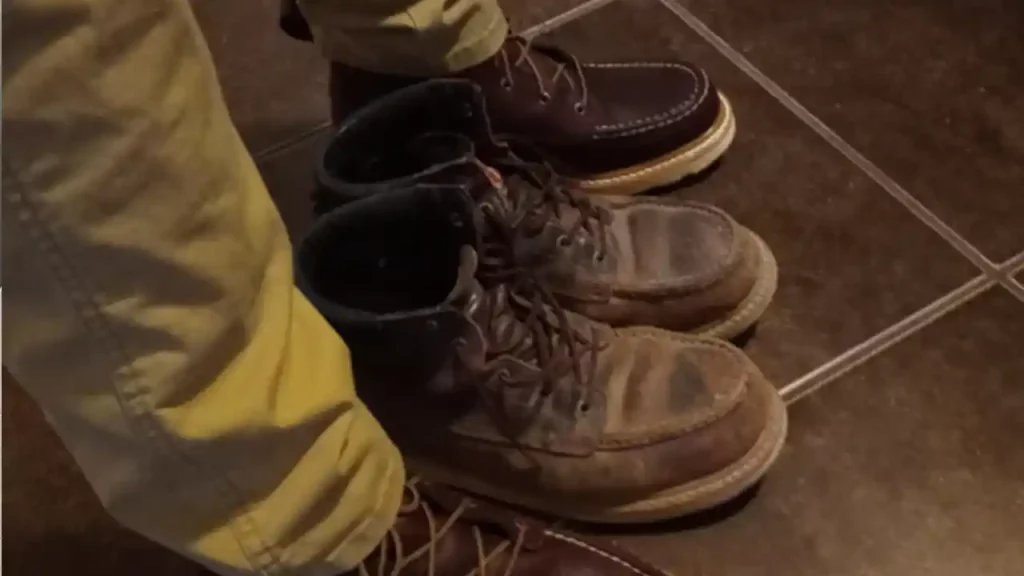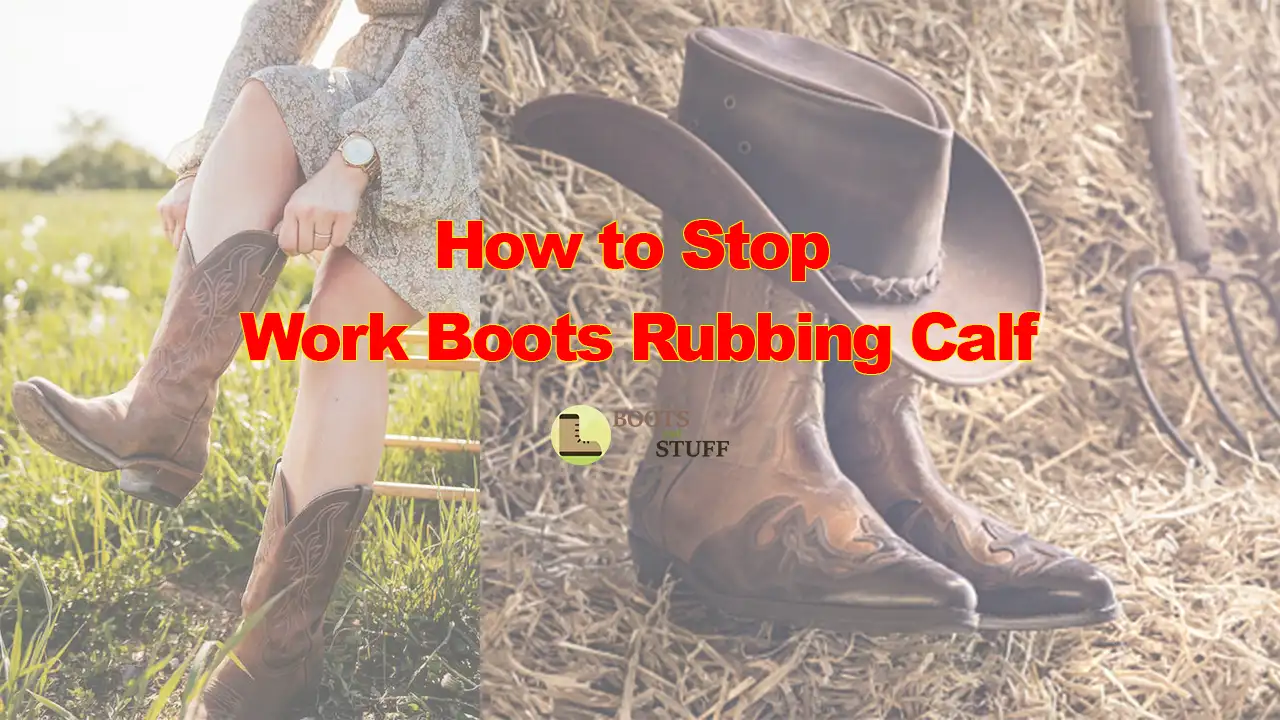You will undoubtedly experience chafing if you wear boots, which most people wear in the winter. Although many other styles of boots also rub on calves, cowboy boots and work boots are the two that rub against calves the majority of the time—a common problem with boots rubbing against the calf. You may prevent rubbing your leg and heel from redness by taking a few steps.
The first tip to prevent the boot from rubbing and chafing is to wear thick socks inside the boot. It will save you from blisters. Second, while buying a new pair of shoes, choose the right size of boots that can give you the proper fit. Boots with hard material and boots that are too tight can rub against your calves. That’s why using boot liners will act as a barrier, and you won’t get blisters.
However, in this article, you will learn why boots cause friction, how to stop boots from rubbing calf, how to keep your feet from chaffing and blistering, and related information.
Contents
- Why Do Boots Rub Calf?
- Why Do My Work Boots Hurt My Feet?
- 1. Not wearing the right size boots
- 2. Not breaking in your boots
- 3. Without utilizing boot inserts
- 4. Dry feet
- 5. Putting on high boots
- How to Stop Boots from Rubbing Your Calf
- Here are a few solutions to prevent boot-rubbing your calf:
- What Makes A Good Work Boot?
- How to keep cowboy boots from rubbing your legs?
- Why Is It Important to Break Cowboy Boots In?
- Healing a Boot Chafing Rash
- Bottom Line
Why Do Boots Rub Calf?
The wrong size is primarily to blame for the discomfort that people who wear boots endure. Too-loose shoes squirm around calf muscles and irritate the skin. When the boots are too tight, your calves may also be rubbed by them, resulting in much friction.
The fact that boots get generally made of stiff, rigid leather and that wearing leather boots for an extended amount of time might result in irritation is another factor contributing to the irritation of the calves. Moreover, suede shoes rub against each other because they are rough and produce friction. Water also irritates the inside of the boots, raising the risk of itching.
Why Do My Work Boots Hurt My Feet?

There are several reasons why your new pair of boots are hurting your feet. It can be anywhere, such as heels, ankles, calves, and feet fingers. Wearing your new boots can sometimes be painful because of all the rubbing and chafing. But why did it happen? Here are the reasons.
1. Not wearing the right size boots
Your calves will surely experience friction if your boots are too tight. Make sure to try on the boots before buying them because it’s crucial to have the right shoe size. Finding the ideal size and fit for your work boots takes a lot of time, but it is worthwhile. By putting on the right size boots, you can solve the rubbing problem.
2. Not breaking in your boots
Before wearing your boots continuously for extended durations, it’s vital to slowly break them in. Start by wearing them briefly while you are at home, and then progressively extend your usage frequency. It will make the boots a little loose and stop them from rubbing.
3. Without utilizing boot inserts
In order to reduce friction, boot inserts can help provide a barrier between your skin and the boot’s material.
4. Dry feet
Dry skin can cause blisters easily. It is important to moisturize your legs to prevent chafing.
5. Putting on high boots
The flesh on your calves will chafe if your boots are too high up. To avoid this, select a lower heel height. You can try mid-calf-length boots.
How to Stop Boots from Rubbing Your Calf

It is tempting to buy leather boots or new boots, but you have to take care of a few things that stop boot-rubbing calves and rubbing heels. If you’re interested in finding out how to prevent boots from rubbing your calves, think about choosing the correct size when you go shopping. If you do not purchase boots that fit snugly, you will almost certainly experience blister and chafing problems.
Here are a few solutions to prevent boot-rubbing your calf:
- Wear the right socks: Stop wearing thick socks to make your new boots tights. Your calf muscles and the boots may rub against your ankle together because of thick socks. Just put on your regular socks. Or wear wool socks which have good cushion cove go for them.
- Use boot inserts: You can buy boot cuffs. Boot cuffs, which are calf-covering linen sleeves, go around the calves. The objective of putting on your boot cuffs is to simulate the appearance of a voluminous sock while adding no actual bulk. Moreover, boot cuffs prevent boot rubbing your calves.
Therefore, guarding against chaffing on your calves. - Choose the right size boots: Using a boot that doesn’t fit properly will cause your feet and calves discomfort. Try using the finger test method to buy the new shoes. After wearing new boots, put your fingers inside the boots gradually. If there is enough room, it is too loose; if your fingers fit but not beyond them, it is too tight. They are the correct size if your fingers fit snugly inside them.
- Wear socks that breathe: Your boots rub against your ankle if your socks do not breathe, resulting in perspiration on your feet. Put on breathable socks made of cotton or other materials.
- Make sure to wear the right attire: Once you buy a new pair, try on the boots and wear attire or socks that correspond to what you will eventually wear with those shoes. By doing this, you can tell if any chafing or other problems are caused by clothing, such as thick socks or jeans.
What Makes A Good Work Boot?
In shoe trees, boots make things so much better. If you are working outside for a long time, boots can protect your feet for a long time. The work boot is an excellent option for those who work in physically demanding or risky professions. For greater endurance during work, they cushion the feet, support them, and give protection.
Firstly, shoes should be made of high-quality materials. A material might shorten a boot’s longevity with poor manufacturing quality before the sole can get fully utilized. Choose the right material to prevent boots from rubbing.
Second, the first fitting should result in a snug fit for the boot. Many shoes require being broken in a little, but if the size is poor right away, the shoe or boot is likely incorrect. Wearing the wrong size will cause friction.
Thirdly, they must be adaptable enough to permit the feet to breathe naturally. Shoes that restrict movement and can cause your feet to injure wearers by twisting their ankles or cutting off blood supply to their feet, leading to various disabling disorders.
How to keep cowboy boots from rubbing your legs?

Cowboy boots get often made of a stiff leather substance that gradually becomes supple and malleable with time. It will feel fantastic when your cowboy boots start to fit more comfortably, and you’ll protect your legs from the constant sting of the leather rubbing against them. To keep your cowboy boots from rubbing and chafing, you must maintain a few things.
- The most significant step is selecting the proper size and fit for your cowboy boots to avoid them rubbing your leg immediately. Choose shoes with the right fit at the calves. Neither the boots are too loose nor tight. Your calves should be able to move around as much as they want in your cowboy boots. The right socks will stop boots from rubbing legs leg, but you must make a place for them.
- If you start to sweat a lot, use powder or talc. Just applying some talc to your calves can significantly reduce sweating and chafing.
- Boot comfort system also relies on leather quality. Boots are made of good quality leather that will stop boot rubbing and keep your calves away from discomfort.
- Tips to prevent boot skin irritations, apply petroleum jelly on your calf muscles. This tip is great for preventing rubbing and scorching since it keeps your calves hydrated.
- Choose a pair of knee-high socks. Consider wearing socks that are higher than your mid-calf. The socks are simple to tuck under your tights.
Why Is It Important to Break Cowboy Boots In?
New cowboy boots rub cause chafing and rubbing problems. Skin irritation and scratching issues get brought on by new cowboy boots. Before you can acquire the ideal, tailored fit, new cowboy boots must get broken in.
Many people’s major issue with their cowboy boots is that they are initially uncomfortable and tight. Although leather can expand, the initial breaking-in stage might be difficult. Knowing how to properly break in cowboy boots will increase the comfort of your boots because the fabric starts to loosen to fit your foot.
Healing a Boot Chafing Rash
Use an anti-friction stick before wearing your boots to avoid developing boot rashes. To prevent blisters or shoe bites, gently apply this to your skin. Alternatively, if you already have rashes, consider some home remedies to treat your foot. We recommend homemade lotion made with coconut oil.
Aloe vera and other calming ointments are effective at-home remedies for chafing. Using clothing that wicks away moisture and putting petroleum jelly on chafe-prone areas are two reasonable precautions that one can take to lessen the probability of getting a rash.
Bottom Line
One of the preferred types of footwear for fieldwork is a boot. Stiff boots can cause irritation and uneasiness. There are some steps you must take if you want to stop your boots from rubbing against your leg and inflaming it. In this discussion, we already explained to you how you could do this.
You must first purchase the proper size of shoes for yourself. Wearing thick socks can cause more friction, so avoid doing so. Wear your brand-new shoes inside the house before venturing outside. These are the basics you need to know. Rest, we’ve already demonstrated.




